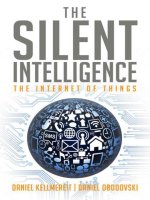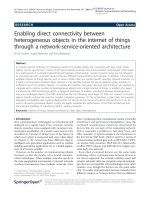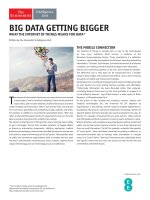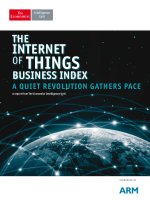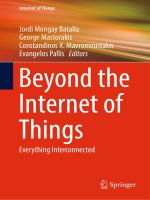Building the internet of things implement new business models, disrupt competitors, transform your industry
Bạn đang xem bản rút gọn của tài liệu. Xem và tải ngay bản đầy đủ của tài liệu tại đây (30.25 MB, 275 trang )
MACIEJ KRANZ
BUILDING
T HE
INTERNE T
OF
THINGS
IMPLEMENT NEW BUSINESS MODELS,
DISRUPT COMPETITORS, AND
TR ANSFORM YOUR INDUSTRY
Cover design: Paul McCarthy
This book is printed on acid-free paper.
Copyright © 2017 by Maciej Kranz. All rights reserved
Published by John Wiley & Sons, Inc., Hoboken, New Jersey
Published simultaneously in Canada
No part of this publication may be reproduced, stored in a retrieval system, or transmitted in any
form or by any means, electronic, mechanical, photocopying, recording, scanning, or otherwise,
except as permitted under Section 107 or 108 of the 1976 United States Copyright Act, without
either the prior written permission of the Publisher, or authorization through payment of the
appropriate per-copy fee to the Copyright Clearance Center, 222 Rosewood Drive, Danvers,
MA 01923, (978) 750-8400, fax (978) 646-8600, or on the web at www.copyright.com. Requests
to the Publisher for permission should be addressed to the Permissions Department, John Wiley &
Sons, Inc., 111 River Street, Hoboken, NJ 07030, (201) 748-6011, fax (201) 748-6008, or online
at www.wiley.com/go/permissions.
Limit of Liability/Disclaimer of Warranty: While the publisher and author have used their best
efforts in preparing this book, they make no representations or warranties with the respect to
the accuracy or completeness of the contents of this book and specifically disclaim any implied
warranties of merchantability or fitness for a particular purpose. No warranty may be created or
extended by sales representatives or written sales materials. The advice and strategies contained
herein may not be suitable for your situation. You should consult with a professional where appro
priate. Neither the publisher nor the author shall be liable for damages arising herefrom.
For general information about our other products and services, please contact our Customer Care
Department within the United States at (800) 762-2974, outside the United States at
(317) 572-3993 or fax (317) 572-4002.
Wiley publishes in a variety of print and electronic formats and by print-on-demand. Some mate
rial included with standard print versions of this book may not be included in e-books or in print
on-demand. If this book refers to media such as a CD or DVD that is not included in the version
you purchased, you may download this material at . For more in
formation about Wiley products, visit www.wiley.com.
Library of Congress Cataloging-in-Publication Data has been applied for and is on fi le with
the Library of Congress.
978-1-119-28566-3 (hardback)
978-1-119-28567-0 (ePDF)
978-1-119-28568-7 (ePUB)
Printed in the United States of America
10
9
8
7
6
5
4
3
2
1
To my wife Kasia
Contents
Foreword
PART 1
ix
A Secure and Transformative IoT Now
Chapter 1 Beyond the Hype—All You Actually Need to
Know About IoT for Business
Generation IoT Drives Business Survival in the 21st Century
1
3
7
A Revolutionary Economic Opportunity
12
IoT Background—A Brief History
14
IoT Today—Digitally Transforming the World
18
Why Now: Three Driving Trends
19
A “Perfect Storm” of Technology, the Economy, and Culture
23
Key Obstacles
25
Scope of the Book
26
How to Read This Book
28
Chapter 2 IoT Is About Change and Transformation
31
Change as the New Status Quo
32
People, Process, Data, Things
36
New Conceptual Paradigm
38
v
vi
Contents
Operational Elements of IoT Success
39
Why Digital Adoption/Transformation?
43
Chapter 3 The Promise of IoT Is Real
IoT Creates Opportunities
51
The Growth of IoT
58
IoT Is Just the Beginning
61
Emerging IoT Ecosystem
64
Startups Join IoT Ranks
67
Collaborate at the Next Level
72
Chapter 4 Understanding the IoT Business Value Proposition
75
Delivering Payback and Business Value
78
Building an IoT Cost Justification
82
Components of IoT Payback
85
Helpful Hints
87
Data Data Everywhere
90
Chapter 5 Four Fast Paths to an Assured IoT Payback
Steps in Starting an IoT Project
PART 2
47
95
99
Aspirational Payback
116
Making IoT Work for Your Organization
121
Chapter 6 Generation IoT Goes to Work
123
More and Different Workers
125
Finding Workers
128
New Positions and Old Positions with a New Twist
132
Interesting IoT Careers
137
IoT Visionaries—Yes, This Will Be a Career,
Starting Now
142
Contents
Chapter 7 Bringing IoT Into Your Organization—Change
Management
147
IoT Solutions
149
Change Management Required
152
Change as the New Status Quo
153
IT/OT Convergence and Other Workforce Issues
155
Changing Roles and Golden Opportunities
158
Learn and Share
159
The Co-Economy
161
Obstacles to Change
163
Exciting IoT Exercise
165
Get in Front of the Coming Change
166
Chapter 8 Mistakes and How to Avoid Them
PART 3
vii
Glimpse Under the Hood of IoT Today and
Tomorrow
Chapter 9 IoT Security Essentials
169
179
181
Physical Separation Provides No Defense
182
Security as One More Risk Management Challenge
184
Radical New Security Approach
187
Some Additional Considerations
191
Perspective from the Experts
193
Challenges of IoT Security
197
Privacy
198
Security as Your IoT Foundation
200
Chapter 10 Standards and Technology
203
The Case for Standards
204
Overabundance of Access Technologies
207
viii
Contents
Common IoT Framework
207
Business-Relevant Standards Activities
210
New Technology Arrivals
213
Chapter 11 IoT State of the Union
221
New Economy
223
Winners and Losers
224
State of the IoT Union Today
227
Era of Innovation and Disruption
229
IoT and the Co-Economy
234
Unavoidable Fact of Life
237
Notes
2
40
Glossary
245
Acknowledgments
251
About the Author
253
Index
254
Foreword
We are inundated with hype around Internet of Things (IoT) today.
There is a need for a book like this—a practical guide that separates the
hype from reality—to direct us to what’s practical and immediately val
uable about IoT and how we can start today and derive tangible benefits
tomorrow.
Today’s reality is that in a world of more than 7 billion people, there
are 70 million who are joining the middle class annually. This growing
middle class generates $8 trillion in consumer spending, and their demands
require manufacturing companies to be more productive, more sustain
able, more flexible, and more cost competitive. Manufacturers must also
ensure global compliance and effectively manage enterprise risks while
improving the connectivity across their business enterprises.
The Internet of Things will significantly impact and change how
global companies conduct business. IoT technologies will transform the
manufacturing environment; it will change more in the next 10 years
than it has in the past 50 years. Cisco estimates there is $3.9 trillion of
value in manufacturing alone for IoT, one of the largest sectors to benefit
from this technology.
The convergence of information technology (IT) and operations
technology (OT) has brought us to an inflection point for realizing a
vision that we call The Connected Enterprise. The foundation of this
vision is our belief that the future of manufacturing is based on standard
unmodified Ethernet and open systems. The combination of information
in the two worlds of IT and OT—seamlessly and securely connecting
ix
x
Foreword
production data with business data and information—results in transfor
mational benefits. And IoT accelerates The Connected Enterprise.
Manufacturers still have a long way to go to realize the full ben
efits of The Connected Enterprise and the fast-emerging IoT. In a
January 2015 Industry Week survey of 581 manufacturing executives and
managers, fewer than 28 percent said their plant floor was Internetenabled. Only 8 percent of larger companies with sales over $1 billion
described their organization as “completely ready” to benefit from the
new IoT technologies. Thus, we need to accelerate the adoption of IoT
technologies.
IoT starts with smart assets that are securely networked over an open,
standard network (Ethernet). We realize the full value of IoT by comple
menting smart, networked assets with contemporary technologies such as
scalable computing, information management, analytics, and mobility, to
create high-value outcomes such as zero downtime and reduced energy
consumption. The Connected Enterprise accelerated by IoT technologies
delivers unprecedented benefits in productivity, sustainability, and global
competitiveness.
Rockwell Automation is proud to be an early pioneer of IoT since
2005. Working with Cisco, we knew that this new technology would
lead the industry through a major transformation, and we are committed
to leading this transformation together. Through innovative collaboration
on products, services, and educational initiatives, we are helping compa
nies achieve successful convergence.
Our collaboration adopted a phased approach. In Phase 1, we initiated
joint product development. So far, we have developed more than 50 prod
ucts together. We joined forces to drive network migration to Ethernet/
IP. We actively engaged with the standards bodies to chart the migration
plans, combining the best of both IT and OT worlds.
In Phase 2, we worked on joint architectures—first a converged plantwide Ethernet (CPwE), then more recently the Secure Industrial Network.
In Phase 3, we moved to building joint solutions. Subsequent phases ena
bled new business models (CAPEX to OPEX), including pay-for-produc
tion performance approaches. Now we are working together to address
the skilled workforce gap with joint certification programs. The history
of our engagements alone present a good set of lessons learned for anyone
working through the adoption of IoT.
Foreword
xi
Over the past 11 years of working with Maciej Kranz, Rockwell
Automation and Cisco have successfully deployed joint products, archi
tectures, and solutions to over 10,000 customers globally. In this book,
Maciej has taken the lessons learned from our IoT journey and shares
them with readers from all industries. Maciej, one of the pioneers of IoT,
has masterfully captured best practices and combined them with practical
guidelines to help readers begin their own IoT journeys.
Our customers continue to be inundated with IoT discussions. This
practical guide helps differentiate the excitement from reality and pro
vides pragmatic advice on starting your own journey along with advice
on planning for the future. I recommend business and technical managers
from every industry read this book to understand how to achieve faster
innovation and higher productivity from a successful implementation of
IoT.
Keith Nosbusch
Chairman, Rockwell Automation
PART
1
A Secure and
Transformative
IoT Now
1
Beyond the
Hype—All You
Actually Need
to Know About
IoT for Business
Like it or not, the Internet of Things (IoT) will change your organization
unlike anything before. It will change your organization more than busi
ness process reengineering (BPR), Six Sigma, lean manufacturing, agile
computing, or any of the other business concepts that periodically pop
up, experience success, and are forgotten when the next big thing arrives.
Granted, to date most of IoT deployments have been incremental and
evolutionary, streamlining an existing process here, cutting some costs
or improving productivity there. That, however, is about to change as
IoT ramps up, as standards are adopted, and as security is bolstered—all
of which and more are in the works. So please don’t misunderstand me.
The Internet of Things certainly will be a big thing—an enormously big
thing, actually. But it isn’t just the next big thing. IoT is the future—your
industry’s future, your organization’s future, and probably your personal
future. Welcome to the future. It’s spelled I-o-T. All this may seem like
hype now, but it will prove in the end to be quite understated; IoT is very,
very real.
3
4
Building the Internet of Things
You still are skeptical. The hype around IoT certainly has become
deafening and distracting. Over the past few years, however, I have trav
eled more than a million miles meeting with people around the world to
discuss IoT. Some of those people have actually done stunning things with
IoT and wanted to show these off for me. Others were struggling with a
problem IoT should be able to solve and wanted to know how their peers
were doing it. Full disclosure: not every business problem, it turns out,
lends itself to an IoT solution.
OK, so are there problems I wouldn’t recommend an IoT solution for?
Not many come to mind immediately. If you insist, for starters there is
the connected home. At the Consumer Electronics Show in Las Vegas you
can see home appliances from washing machines to coffee makers con
nected to the Internet and to each other. The problem: while I see value
in connecting individual home devices to the Internet, the business case
for connecting all appliances and devices to each other in the mainstream
home is just not there yet. There are a few emerging use cases, for example,
home security and elder care where specialized devices in the home have to
be interconnected, but an immediate IoT payoff is still some distance away.
In truth, most of the current implementations of IoT are in the
business-to-business (B2B) area and are focused on improved efficiency
and productivity around existing processes. As I said, IoT gains are
incremental at this point. The real payoff from IoT comes down to auto
mating existing processes that have a large labor or time component and
streamlining the related process in one way or another. The resulting
improvements, despite having measureable business impact, are mostly
evolutionary. Similarly, you, too, after reading this book, should focus
first on streamlining and improving your existing processes, which will
deliver your fast paybacks and set you on the path toward more revolution
ary applications, new business models, and incremental revenue streams.
For example, you might use IoT to automate a data collection process you
now do manually or remotely monitor something that otherwise requires
a person to actually visit. Such solutions are already well proven and doc
umented. I do, however, expect that down the road many breakthroughs
in IoT will also come from the B2B2C (business to business to consumer)
domain, but today they are just starting to emerge, pioneered by early
adopters: processes like mass customization, food safety, and even auto
nomic car or drone transportation/delivery (see Figure 1.1).
Beyond the Hype—All You Actually Need to Know About IoT for Business
Figure 1.1
5
B2B and B2B2C Domains
In the meantime, manufacturing around the world, including in
North America, is having a renaissance of sorts, and IoT is part of the
reason. By converging previously siloed sensors, machines, cells, and
zones, IoT-driven factory automation helps enterprises integrate pro
duction and business systems and then bring everything online over a
single network. Organizations are gaining flexibility to quickly adapt to
changes, whether for new product introductions, planned product line
changeovers, or other adjustments. Each affected zone, from the enter
prise to the plant floor to the loading dock, receives real-time alerts
about changes through networked mobile devices, video monitors, and
human-machine interfaces. The real-time information also links back to
the entire supply chain, so each step in the manufacturing value chain,
from supply through production to distribution, can respond as quickly
as needed.
These represent evolutionary improvements that together deliver
real business value. Similar gains are being achieved in transportation,
6
Building the Internet of Things
utilities, agriculture, building automation, education, retail, health care,
sports, and entertainment—even the military. Companies in these indus
tries are taking first steps on their IoT journeys starting with low-hang
ing fruit. Still, the process improvements are real and the paybacks, the
ROI, add up to serious money in the bank, as I will demonstrate in
Chapters 3 and 4.
So this isn’t theory. It’s real, and it’s working today. What a better
example than a legendary American motorcycle manufacturer, HarleyDavidson Motor Company. The company was facing intense global com
petition while its core market was aging and new younger buyers wanted
a different type of motorcycle.1 It needed to get agile, to be able to respond
to changes fast, and to be more efficient and productive. IoT gave HarleyDavidson the capabilities it needed. Here’s how.
Harley-Davidson faced the familiar litany of problems encountered
by many American businesses, especially large and market-leading com
panies or those with ambitions to be so in their industry. Labor was too
costly. Production was not aligned with IT operations. Islands of incom
patible data were everywhere. “You name it, we suffered from it,” one
former Harley manager told me.
So the company pulled together key people from both IT and oper
ations (known as operational technology, or OT). In every industry and
most businesses, IT and OT are notoriously uncooperative, almost as if
IT, as the book title says, was from Venus and OT from Mars. We’re not
talking about a mass revolution here: more like a couple of people from
different groups who got together by themselves and started actually talk
ing to each other. Later they pulled in a few others and sat together in
a room until they formed a unified team willing to communicate with
each other and with other Harley-Davidson business units to gain the effi
ciencies IoT could deliver. The company converged its multiple networks
into a single network and began consolidating data islands. As of this
writing, one Harley-Davidson factory is fully IoT-enabled. The results
are impressive. “What used to take a painfully long time to triage and
troubleshoot now can be accomplished in a single morning,” the manager
said, an order of magnitude improvement. That alone led to increased
productivity, efficiency, flexibility, and agility. The results have been so
astonishing that other Harley-Davidson factories are clamoring to be the
next adopters of IoT.
Beyond the Hype—All You Actually Need to Know About IoT for Business
7
Moreover, those are just the operational results. Harley-Davidson’s
strategic business outcomes from the IoT-induced changes are equally
impressive:
■
■
■
■
■
■
Eighty percent faster decision making due to workforce enablement
Dramatic reductions in costs and set-up time
Continuous asset management, enabling even better decision making
6.8 percent increase in production throughput due to asset tagging
Ten to 25 times improvement in build-to-order (BTO) cycle times
(18 months reduced to two weeks)
Seven to 12 percent increase in IoT automation-driven equipment
utilization
All of this led to a profitability increase between 3 and 4 percent. And
that was just one factory!
Harley-Davidson bet its future survival on IoT and, from its first
IoT-enabled factory, it began paying off big (see Figure 1.2). This same
future attracts what I refer to as Generation IoT everywhere.
Generation IoT Drives Business Survival
in the 21st Century
If you look at the last 25 years of the tech industry, you’ll see that change
has been constant. Every three to seven years, organizations had to rein
vent themselves. Companies that missed one technology transition could
possibly recover if they scrambled to catch up. Those that missed two,
however, most likely perished. Interestingly, according to The Boston
Consulting Group, when you look at the roster of S&P 500 companies
from 50 years ago, only 19 percent are still in existence.2 The rest have
perished.
As the S&P 500’s mortality shows, we’re so used to change that we
barely notice it occurring. Remember tape recorders, CDs, VHS tapes,
and answering machines? The advent of each changed society in substan
tive ways. When I asked my children about CDs and VHS tapes, I got
blank stares. What about home telephones? I recently met a teenager who
didn’t recognize a telephone busy signal when she heard it; she had never
experienced the phenomenon. When it was explained, she was baffled.
8
Building the Internet of Things
Figure 1.2
Harley-Davidson Case
Beyond the Hype—All You Actually Need to Know About IoT for Business
9
Everyone has voicemail and call waiting, she insisted. Tape recorders,
CDs, VHS tapes, and answering machines are maybe 30 years old, and yet
they’re not only obsolete but also now forgotten. Their replacements are
now integrated into your smartphone. Society and business keep moving
forward.
This is as good a point as any to tell you about me, your author.
Obviously I’m a father with a bunch of kids, but what’s important to you is
my experience with IoT. My IoT journey started 12 years ago as a manager
at Cisco when several of us flew to Cleveland and started working on in
dustrial Ethernet switches together with Rockwell Automation. It was a
challenging assignment for our team, encompassing a completely new set
of requirements, certifications, and accommodating so many ruggedized
systems versions, but we got things to work. A few years later, we decided
that the time was right for Cisco to focus on the industrial networking
segment, and we created the Connected Industries Group, which I ran.
We also decided to adopt the IoT term to describe the phenomenon of
everything connecting to everything. Anyway, this is how I started.
From there our plan for IoT was to expand our ruggedized infra
structure portfolio, develop vertical solutions expertise, build a partner
ecosystem to augment our own skills—even then we realized that IoT
would be bigger than any one organization could do on its own—and
offer a platform for real-time analytics and vertical applications. We also
evangelized IoT to the rest of the industry with the goal of getting them
excited about its potential so that together we could turn the IoT vision
into a huge market opportunity for everybody. Judging from the latest
independent industry projections of billions of connected devices in just
a few years and trillions in revenue, it has worked out pretty well to date.
The important part, however, is that we have started to deliver on that
promise. Now, if you haven’t done so already, I hope that after reading
this book you will join us as well by introducing your organization to IoT
and participate in the IoT economy.
Today, the pace of change is more than a constant; it’s the new status
quo. The Millennials now entering the workforce know only unrelenting
change. To them it’s a way of life, one that will likely continue for the rest
of their lives. But no matter our actual age, we are all part of a generation
poised to encounter revolutionary change. That’s why I call what we’re
experiencing in every business segment Generation IoT.
10
Building the Internet of Things
So how does your business survive in this environment? How do
you avoid the mortality we’ve seen among the S&P 500? That’s what this
book is about—understanding this emerging change that has just begun
to sweep over us and finding a strategy that will ensure your business and
your career not only survive but thrive. The winners in this new era will
recognize the changes occurring around us and be willing to adjust and
re-learn, over and over again. They are Generation IoT.
So how do we spot these winners? You belong to Generation IoT if
you embrace open standards, open collaboration, open communications,
and open, flexible business models and you’re willing to assemble a com
prehensive partner ecosystem to build and deploy agile, flexible business
solutions. The losers, however, will insistently stick to the old ways of
doing business or try to do it all themselves. We’ve seen them many times
in the past. They run their operations on proprietary or semi-standard
technologies and adopt business models that lock in customers, ultimately
destroying whatever value they initially delivered.
Need another example of IoT-led transformation? How about Ford
Motor Company, a major U.S. automaker? It hasn’t been long since the
company together with its peers was on the ropes during the financial
crises. Today, Ford has smartened up and changed processes. Of its 40
vehicle assembly plants, 25 now use IoT technology to speed commu
nications within and between them. Plants around the world are now
connected to the Ford enterprise network. Moreover, its next-generation
automated vehicle scheduling system manages production in real time,
handling more than 2 million variations. As a result, Ford is selling more
cars than ever before. Thank you, IoT.
First Step on IoT Security Journey
The ability to deal effectively with security threats is the number 1
make-or-break factor for IoT adoption. Without it, companies will
be reluctant to implement IoT and thus not benefit from the grow
ing number of powerful use cases emerging across all industries.
The industry recognizes the challenge and is making it the top
priority. IoT security is starting to be integrated into the very fabric
Beyond the Hype—All You Actually Need to Know About IoT for Business
11
of both industry and public infrastructure, including fundamental
areas such as transportation and logistics, power grids, water sup
plies, and public safety. However, much more needs to be done. We
still lack skills, education, and awareness. Many companies con
tinue to be in denial, still relying on a discredited physical separa
tion approach to securing their plants and infrastructure. The OT
and IT divide prevents the companies from implementing modern
and proven security best practices.
So how should organizations start to approach IoT security?
According to Verizon’s “2015 Data Breach Investigations Report,”
most security breaches exploit well-known vulnerabilities where
companies have not applied available fixes. The first step, therefore,
is to implement existing best practices by following these three sets
of guidelines:
■
■
■
Adopt a single policy-based security architecture built on an
open, unified approach with automated, risk-based self-defense
and self-healing capabilities.
Converge around standards. Vendors and enterprises alike
need to leverage IT industry standards and best practices in OT
and to fill in the gaps between industry-specific and horizontal
standards organizations.
Collaborate. OT, IT, information security teams (CiSO), to
gether with vendors and consultants, must work together on
common architectures, incorporating not only OT require
ments into the IT provider’s product portfolio but also support
ing form-factors, up-time requirements, and integration with
legacy industrial protocols. Security isn’t your differentiation;
it’s your foundation. Therefore, let’s learn and share together.
Yes, IoT is different than IT in many ways: it is more distrib
uted, more heterogeneous, and more dynamic. There are many new
IoT scenarios that require brand new approaches to security. We
will explore them in more detail in Chapter 9. But the first step on
the IoT security journey is to leverage 30+ years of experience and
best practices that IT security systems give us. So let’s not reinvent
the wheel.

